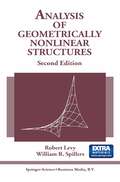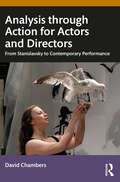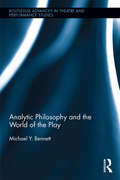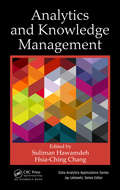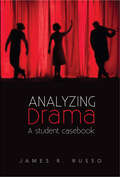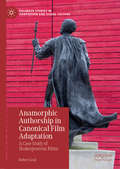- Table View
- List View
An Analysis of Alasdair MacIntyre's After Virtue (The Macat Library)
by Jon W. ThompsonAlasdair MacIntyre’s 1981 After Virtue was a ground-breaking contribution to modern moral philosophy. Dissatisfied with the major trends in the moral philosophy of his time, MacIntyre argued that modern moral discourse had no real rational basis. Instead, he suggested, if one wanted to build a rational theory for morality and moral actions, one would have to go all the way back to Aristotle. To build his arguments – which are widely acknowledged to be as important as they are complex – MacIntyre relies on two critical thinking skills above all others: evaluation and interpretation. The primary goal of evaluation is to judge the strength or weakness of arguments, asking how acceptable a given line of reasoning is, and how adequate it is to the situation. In After Virtue, MacIntyre applies incisive evaluation skills to major positions and figures in moral philosophy one after the other – showing how and why Aristotle’s template remains a stronger way of considering moral questions. Throughout this process, MacIntyre also relies on his interpretative skills. As MacIntyre knows, clarifying meanings, questioning definitions, and laying down definitions of his key terms is as vital to advancing his arguments as it is to evaluating those of other philosophers.
An Analysis of Albert Hourani's A History of the Arab Peoples (The Macat Library)
by J. A. Brown Bryan GibsonFew works of history make as well-structured a case for the importance of studying continuity, rather than change, than Albert Hourani's A History of the Arab Peoples. Hourani’s work had three major aims: to refute the idea that Arab society stagnated between 1000 and 1800; to study the period through the lens of diverse Arab, rather than Muslim, history; and to stress intellectual and cultural continuity. All of these intentions were the product of the author’s evaluation of a great mass of secondary sources, many of them devoted to arguing for ideas that contradicted his, and it demanded considerable skill to synthesize from them a coherent and well-evidenced counter-argument. Hourani was able to do this largely because his grasp of the relevance and adequacy of his predecessors' arguments was second to none; his achievement lies in his ability to reject the reasoning of other historians while still making good use of their evidence. In this task, he was aided by an interpretative skill almost equal to his powers of evaluation; A History of the Arab Peoples is also a monument to the importance of properly understanding the meaning of available evidence.
An Analysis of Albert Hourani's A History of the Arab Peoples (The Macat Library)
by J. A. Brown Bryan GibsonFew works of history make as well-structured a case for the importance of studying continuity, rather than change, than Albert Hourani's A History of the Arab Peoples. Hourani’s work had three major aims: to refute the idea that Arab society stagnated between 1000 and 1800; to study the period through the lens of diverse Arab, rather than Muslim, history; and to stress intellectual and cultural continuity. All of these intentions were the product of the author’s evaluation of a great mass of secondary sources, many of them devoted to arguing for ideas that contradicted his, and it demanded considerable skill to synthesize from them a coherent and well-evidenced counter-argument. Hourani was able to do this largely because his grasp of the relevance and adequacy of his predecessors' arguments was second to none; his achievement lies in his ability to reject the reasoning of other historians while still making good use of their evidence. In this task, he was aided by an interpretative skill almost equal to his powers of evaluation; A History of the Arab Peoples is also a monument to the importance of properly understanding the meaning of available evidence.
Analysis of Engineering Drawings and Raster Map Images
by Thomas C. HendersonThis book covers up-to-date methods and algorithms for the automated analysis of engineering drawings and digital cartographic maps. The Non-Deterministic Agent System (NDAS) offers a parallel computational approach to such image analysis. The book describes techniques suitable for persistent and explicit knowledge representation for engineering drawings and digital maps. It also highlights more specific techniques, e.g., applying robot navigation and mapping methods to this problem. Also included are more detailed accounts of the use of unsupervised segmentation algorithms to map images. Finally, all these threads are woven together in two related systems: NDAS and AMAM (Automatic Map Analysis Module).
Analysis of Experimental Algorithms: Special Event, SEA² 2019, Kalamata, Greece, June 24-29, 2019, Revised Selected Papers (Lecture Notes in Computer Science #11544)
by Ilias Kotsireas Panos Pardalos Konstantinos E. Parsopoulos Dimitris Souravlias Arsenis TsokasThis book constitutes the refereed post-conference proceedings of the Special Event on the Analysis of Experimental Algorithms, SEA² 2019, held in Kalamata, Greece, in June 2019.The 35 revised full papers presented were carefully reviewed and selected from 45 submissions. The papers cover a wide range of topics in both computer science and operations research/mathematical programming. They focus on the role of experimentation and engineering techniques in the design and evaluation of algorithms, data structures, and computational optimization methods.
Analysis of Geometrically Nonlinear Structures
by Robert Levy William R. SpillersThe availability of computers has, in real terms, moved forward the practice of structural engineering. Where it was once enough to have any analysis given a complex configuration, the profession today is much more demanding. How engineers should be more demanding is the subject of this book. In terms of the theory of structures, the importance of geometric nonlinearities is explained by the theorem which states that "In the presence of prestress, geometric nonlinearities are of the same order of magnitude as linear elastic effects in structures. " This theorem implies that in most cases (in all cases of incremental analysis) geometric nonlinearities should be considered. And it is well known that problems of buckling, cable nets, fabric structures, ... REQUIRE the inclusion of geometric nonlinearities. What is offered in the book which follows is a unified approach (for both discrete and continuous systems) to geometric nonlinearities which incidentally does not require a discussion of large strain. What makes this all work is perturbation theory. Let the equations of equilibrium for a system be written as where P represents the applied loads, F represents the member forces or stresses, and N represents the operator which describes system equilibrium.
Analysis of Images, Social Networks and Texts: 8th International Conference, AIST 2019, Kazan, Russia, July 17–19, 2019, Revised Selected Papers (Lecture Notes in Computer Science #11832)
by Wil M. P. van der Aalst Vladimir Batagelj Dmitry I. Ignatov Michael Khachay Valentina Kuskova Andrey Kutuzov Sergei O. Kuznetsov Irina A. Lomazova Natalia Loukachevitch Amedeo Napoli Panos M. Pardalos Marcello Pelillo Andrey V. Savchenko Elena TutubalinaThis book constitutes the post-conference proceedings of the 8th International Conference on Analysis of Images, Social Networks and Texts, AIST 2019, held in Kazan, Russia, in July 2019. The 27 full and 8 short papers were carefully reviewed and selected from 134 submissions (of which 21 papers were automatically rejected without being reviewed). The papers are organized in topical sections on general topics of data analysis; natural language processing; social network analysis; analysis of images and video; optimization problems on graphs and network structures; and analysis of dynamic behavior through event data.
The Analysis of Performance Art: A Guide to its Theory and Practice
by Anthony Howell A. HowellThis finely illustrated book offers a simple yet comprehensive 'grammar' of a new discipline. Performance Art first became popular in the fifties when artists began creating 'happenings'. Since then the artist as a performer has challenged many of the accepted rules of the theatre and radically altered our notion of what constitutes visual art. This is the first publication to outline the essential characteristics of the field and to put forward a method for teaching the subject as a discipline distinct from dance, drama, painting or sculpture.Taking the theory of primary and secondary colours as his model, Anthony Howell posits three primaries of action and shows how these may be mixed to obtain a secondary range of actions. Based on a taught course, the system is designed for practical use in the studio and is also entertaining to explore. Examples are cited from leading performance groups and practitioners such as Bobbie Baker, Orlan, Stelarc, Annie Sprinkle, Robert Wilson, Goat Island, and Station House Opera. This volume, however, is not just an illustrated grammar of action - it also shows how the syntax of that grammar has psychoanalytic repercussions. This enables the performer to relate the system to lived experience, ensuring a realisation that meaning is being dealt with through these actions and that the stystem set forth is more than a dry structuring of the characteristics of movement.Freud's notion of 'transference' and Lacan's understanding of 'repetition' are compared to a performer's usage of the same terms. Thus the book provides a psychoanalytic critique of performance at the same time as it outlines an efficient method for creating live work on both fine art and theatre courses.
The Analysis of Performance Art: A Guide to its Theory and Practice
by Anthony Howell A. HowellThis finely illustrated book offers a simple yet comprehensive 'grammar' of a new discipline. Performance Art first became popular in the fifties when artists began creating 'happenings'. Since then the artist as a performer has challenged many of the accepted rules of the theatre and radically altered our notion of what constitutes visual art. This is the first publication to outline the essential characteristics of the field and to put forward a method for teaching the subject as a discipline distinct from dance, drama, painting or sculpture.Taking the theory of primary and secondary colours as his model, Anthony Howell posits three primaries of action and shows how these may be mixed to obtain a secondary range of actions. Based on a taught course, the system is designed for practical use in the studio and is also entertaining to explore. Examples are cited from leading performance groups and practitioners such as Bobbie Baker, Orlan, Stelarc, Annie Sprinkle, Robert Wilson, Goat Island, and Station House Opera. This volume, however, is not just an illustrated grammar of action - it also shows how the syntax of that grammar has psychoanalytic repercussions. This enables the performer to relate the system to lived experience, ensuring a realisation that meaning is being dealt with through these actions and that the stystem set forth is more than a dry structuring of the characteristics of movement.Freud's notion of 'transference' and Lacan's understanding of 'repetition' are compared to a performer's usage of the same terms. Thus the book provides a psychoanalytic critique of performance at the same time as it outlines an efficient method for creating live work on both fine art and theatre courses.
Analysis of Verbal and Nonverbal Communication and Enactment.The Processing Issues: COST 2102 International Conference, Budapest, Hungary, September 7-10, 2010, Revised Selected Papers (Lecture Notes in Computer Science #6800)
by Anna Esposito Alessandro Vinciarelli Klara Vicsi Catherine Pelachaud Anton NijholtThis volume brings together the advanced research results obtained by the European COST Action 2102 "Cross Modal Analysis of Verbal and Nonverbal Communication", primarily discussed at the PINK SSPnet-COST2102 International Conference on Analysis of Verbal and Nonverbal Communication and Enactment: The Processing Issues, held in Budapest, Hungary, in September 2010. The 40 papers presented were carefully reviewed and selected for inclusion in the book. The volume is arranged into two scientific sections. The first section, Multimodal Signals: Analysis, Processing and Computational Issues, deals with conjectural and processing issues of defining models, algorithms, and heuristic strategies for data analysis, coordination of the data flow and optimal encoding of multi-channel verbal and nonverbal features. The second section, Verbal and Nonverbal Social Signals, presents original studies that provide theoretical and practical solutions to the modelling of timing synchronization between linguistic and paralinguistic expressions, actions, body movements, activities in human interaction and on their assistance for an effective human-machine interactions.
An Analysis of Virginia Woolf's A Room of One's Own (The Macat Library)
by Tim Smith-Laing Fiona RobinsonA Room of One's Own is a very clear example of how creative thinkers connect and present things in novel ways. Based on the text of a talk given by Virginia Woolf at an all-female Cambridge college, Room considers the subject of 'women and fiction.' Woolf’s approach is to ask why, in the early 20th century, literary history presented so few examples of canonically 'great' women writers. The common prejudices of the time suggested this was caused by (and proof of) women's creative and intellectual inferiority to men. Woolf argued instead that it was to do with a very simple fact: across the centuries, male-dominated society had systematically prevented women from having the educational opportunities, private spaces and economic independence to produce great art. At a time when 'art' was commonly considered to be a province of the mind that had no relation to economic circumstances, this was a novel proposal. More novel, though, was Woolf's manner of arguing and proving her contentions: through a fictional account of the limits placed on even the most privileged women in everyday existence. An impressive early example of cultural materialism, A Room of One's Own is an exemplary encapsulation of creative thinking.
An Analysis of Virginia Woolf's A Room of One's Own (The Macat Library)
by Tim Smith-Laing Fiona RobinsonA Room of One's Own is a very clear example of how creative thinkers connect and present things in novel ways. Based on the text of a talk given by Virginia Woolf at an all-female Cambridge college, Room considers the subject of 'women and fiction.' Woolf’s approach is to ask why, in the early 20th century, literary history presented so few examples of canonically 'great' women writers. The common prejudices of the time suggested this was caused by (and proof of) women's creative and intellectual inferiority to men. Woolf argued instead that it was to do with a very simple fact: across the centuries, male-dominated society had systematically prevented women from having the educational opportunities, private spaces and economic independence to produce great art. At a time when 'art' was commonly considered to be a province of the mind that had no relation to economic circumstances, this was a novel proposal. More novel, though, was Woolf's manner of arguing and proving her contentions: through a fictional account of the limits placed on even the most privileged women in everyday existence. An impressive early example of cultural materialism, A Room of One's Own is an exemplary encapsulation of creative thinking.
Analysis through Action for Actors and Directors: From Stanislavsky to Contemporary Performance
by David ChambersAnalysis through Action for Actors and Directors is a comprehensive view of an innovative and exciting process for making new theatre.As well as an understanding of how Analysis through Action has developed over time, this book also demonstrates how it can be put into practice in today’s theatre. The first part of this book traces the exciting genealogy from Stanislavsky’s unfinished experiments, through the insights of geniuses Maria Knebel and Georgii Tovstonogov, down to today’s avant-garde auteurs. The second part is a practical manual based on extensive field testing by the author and colleagues. Here, two key components of the process are elucidated: Text Actions – ten interwoven text analysis steps – to be twinned with the thrilling rehearsal process using focused and joyful improvisations called Études.Written for new or experienced theatre students and practitioners, this book will enrich the technique of any theatre artist and anyone else interested in the theatre and its future.
Analysis through Action for Actors and Directors: From Stanislavsky to Contemporary Performance
by David ChambersAnalysis through Action for Actors and Directors is a comprehensive view of an innovative and exciting process for making new theatre.As well as an understanding of how Analysis through Action has developed over time, this book also demonstrates how it can be put into practice in today’s theatre. The first part of this book traces the exciting genealogy from Stanislavsky’s unfinished experiments, through the insights of geniuses Maria Knebel and Georgii Tovstonogov, down to today’s avant-garde auteurs. The second part is a practical manual based on extensive field testing by the author and colleagues. Here, two key components of the process are elucidated: Text Actions – ten interwoven text analysis steps – to be twinned with the thrilling rehearsal process using focused and joyful improvisations called Études.Written for new or experienced theatre students and practitioners, this book will enrich the technique of any theatre artist and anyone else interested in the theatre and its future.
Analytic Philosophy and the World of the Play (Routledge Advances in Theatre & Performance Studies)
by Michael Y. BennettTheatrical characters’ dual existence on stage and in text presents a unique, challenging case for the analytical philosopher. Analytic Philosophy and the World of the Play re-examines the ontological status of theatre and its fictional objects through the "possible worlds" thesis, arguing that theatre is not a mirror of our world, but a re-creation of it. Taking a fresh look at theatre’s key elements, including the hotly contested relationships between character and actor; onstage and offstage "worlds"; and the play-text and performance, Michael Y. Bennett presents a radical new way of understanding the world of the play.
Analytic Philosophy and the World of the Play (Routledge Advances in Theatre & Performance Studies)
by Michael Y. BennettTheatrical characters’ dual existence on stage and in text presents a unique, challenging case for the analytical philosopher. Analytic Philosophy and the World of the Play re-examines the ontological status of theatre and its fictional objects through the "possible worlds" thesis, arguing that theatre is not a mirror of our world, but a re-creation of it. Taking a fresh look at theatre’s key elements, including the hotly contested relationships between character and actor; onstage and offstage "worlds"; and the play-text and performance, Michael Y. Bennett presents a radical new way of understanding the world of the play.
Analytical and Stochastic Modelling Techniques and Applications: 22nd International Conference, ASMTA 2015, Albena, Bulgaria, May 26-29, 2015. Proceedings (Lecture Notes in Computer Science #9081)
by Marco Gribaudo Daniele Manini Anne RemkeThis book constitutes the refereed proceedings of the 22nd International Conference on Analytical and Stochastic Modelling Techniques and Applications, ASMTA 2015, held in Albena, Bulgaria, in May 2015. The 15 full papers presented in this book were carefully reviewed and selected from numerous submissions. The papers discuss the latest developments in analytical, numerical and simulation algorithms for stochastic systems, including Markov processes, queueing networks, stochastic Petri nets, process algebras, game theory, etc.
Analytics and Knowledge Management (Data Analytics Applications)
by Suliman Hawamdeh Hsia-Ching ChangThe process of transforming data into actionable knowledge is a complex process that requires the use of powerful machines and advanced analytics technique. Analytics and Knowledge Management examines the role of analytics in knowledge management and the integration of big data theories, methods, and techniques into an organizational knowledge management framework. Its chapters written by researchers and professionals provide insight into theories, models, techniques, and applications with case studies examining the use of analytics in organizations. The process of transforming data into actionable knowledge is a complex process that requires the use of powerful machines and advanced analytics techniques. Analytics, on the other hand, is the examination, interpretation, and discovery of meaningful patterns, trends, and knowledge from data and textual information. It provides the basis for knowledge discovery and completes the cycle in which knowledge management and knowledge utilization happen. Organizations should develop knowledge focuses on data quality, application domain, selecting analytics techniques, and on how to take actions based on patterns and insights derived from analytics. Case studies in the book explore how to perform analytics on social networking and user-based data to develop knowledge. One case explores analyze data from Twitter feeds. Another examines the analysis of data obtained through user feedback. One chapter introduces the definitions and processes of social media analytics from different perspectives as well as focuses on techniques and tools used for social media analytics. Data visualization has a critical role in the advancement of modern data analytics, particularly in the field of business intelligence and analytics. It can guide managers in understanding market trends and customer purchasing patterns over time. The book illustrates various data visualization tools that can support answering different types of business questions to improve profits and customer relationships. This insightful reference concludes with a chapter on the critical issue of cybersecurity. It examines the process of collecting and organizing data as well as reviewing various tools for text analysis and data analytics and discusses dealing with collections of large datasets and a great deal of diverse data types from legacy system to social networks platforms.
Analytics and Knowledge Management (Data Analytics Applications)
by Suliman Hawamdeh and Hsia-Ching ChangThe process of transforming data into actionable knowledge is a complex process that requires the use of powerful machines and advanced analytics technique. Analytics and Knowledge Management examines the role of analytics in knowledge management and the integration of big data theories, methods, and techniques into an organizational knowledge management framework. Its chapters written by researchers and professionals provide insight into theories, models, techniques, and applications with case studies examining the use of analytics in organizations. The process of transforming data into actionable knowledge is a complex process that requires the use of powerful machines and advanced analytics techniques. Analytics, on the other hand, is the examination, interpretation, and discovery of meaningful patterns, trends, and knowledge from data and textual information. It provides the basis for knowledge discovery and completes the cycle in which knowledge management and knowledge utilization happen. Organizations should develop knowledge focuses on data quality, application domain, selecting analytics techniques, and on how to take actions based on patterns and insights derived from analytics. Case studies in the book explore how to perform analytics on social networking and user-based data to develop knowledge. One case explores analyze data from Twitter feeds. Another examines the analysis of data obtained through user feedback. One chapter introduces the definitions and processes of social media analytics from different perspectives as well as focuses on techniques and tools used for social media analytics. Data visualization has a critical role in the advancement of modern data analytics, particularly in the field of business intelligence and analytics. It can guide managers in understanding market trends and customer purchasing patterns over time. The book illustrates various data visualization tools that can support answering different types of business questions to improve profits and customer relationships. This insightful reference concludes with a chapter on the critical issue of cybersecurity. It examines the process of collecting and organizing data as well as reviewing various tools for text analysis and data analytics and discusses dealing with collections of large datasets and a great deal of diverse data types from legacy system to social networks platforms.
Analyzing Drama: A Student Casebook
by James R RussoThis play-analysis textbook contains 50 short essays on geographically diverse, historically significant dramas -- among them Major Barbara, Our Town, Hamlet, A Streetcar Named Desire, Romeo and Juliet, Miss Julie, Electra, Death of a Salesman, The Balcony, The Cherry Orchard, Mother Courage, The Merry Wives of Windsor, and Old Times. The essays are supported by a Step-by-Step Approach to Play Analysis, a Glossary of Dramatic Terms, Study Guides, Topics for Writing and Discussion, Bibliographical Resources, and a comprehensive Index. Written for university and advanced high school students, these critical essays provide practical models to aid and promote writing and analytical skills. The author is a close reader committed to a detailed yet objective examination of the structure, style, imagery, and language of a play. He is concerned with dramatic analysis that can be of benefit to directors, designers, and even actors. Analysis of character, action, dialogue, and setting can thus be translated into concepts for theatrical production. The three key benefits of ANALYZING DRAMA are: 1. Most so-called play analysis texts are books about the methods and techniques of play analysis but contain few (if any) actual play analyses. The book describes the methods and techniques of play analysis while at the same time providing numerous examples of such analysis. 2. The Topics for Writing and Discussion and Study Guides provide a wide range of set tasks for students. 3. Readings are not biased by any particular social or political doctrine. Aimed at students, teachers, educated readers, and drama aficionados with an interest in world drama in particular and drama studies in general, as well as at theatregoers with an interest in the practice of play analysis and criticism.
Analyzing Drama: A Student Casebook
by James R RussoThis play-analysis textbook contains 50 short essays on geographically diverse, historically significant dramas -- among them Major Barbara, Our Town, Hamlet, A Streetcar Named Desire, Romeo and Juliet, Miss Julie, Electra, Death of a Salesman, The Balcony, The Cherry Orchard, Mother Courage, The Merry Wives of Windsor, and Old Times. The essays are supported by a Step-by-Step Approach to Play Analysis, a Glossary of Dramatic Terms, Study Guides, Topics for Writing and Discussion, Bibliographical Resources, and a comprehensive Index. Written for university and advanced high school students, these critical essays provide practical models to aid and promote writing and analytical skills. The author is a close reader committed to a detailed yet objective examination of the structure, style, imagery, and language of a play. He is concerned with dramatic analysis that can be of benefit to directors, designers, and even actors. Analysis of character, action, dialogue, and setting can thus be translated into concepts for theatrical production. The three key benefits of ANALYZING DRAMA are: 1. Most so-called play analysis texts are books about the methods and techniques of play analysis but contain few (if any) actual play analyses. The book describes the methods and techniques of play analysis while at the same time providing numerous examples of such analysis. 2. The Topics for Writing and Discussion and Study Guides provide a wide range of set tasks for students. 3. Readings are not biased by any particular social or political doctrine. Aimed at students, teachers, educated readers, and drama aficionados with an interest in world drama in particular and drama studies in general, as well as at theatregoers with an interest in the practice of play analysis and criticism.
Analyzing Literature-to-Film Adaptations: A Novelist's Exploration and Guide
by Mary H. SnyderThe majority of scholarly treatments for film adaptation are put forth by experts on film and film analysis, thus with the focus being on film. Analyzing Literature-to-Film Adaptations looks at film adaptation from a fresh perspective, that of writer or creator of literary fiction. In her book, Snyder explores both literature and film as separate entities, detailing the analytical process of interpreting novels and short stories, as well as films. She then introduces a means to analyzing literature-to-film adaptations, drawing from the concept of intertextual comparison. Snyder writes not only from the perspective of a fiction writer but also as an instructor of writing, literature, and film adaptation. She employs the use of specific film adaptations (Frankenstein, Children of Men, Away from Her) to show the analytical process put into practice. Her approach to film adaptation is designed for students just beginning their academic journey but also for those students well on their way. The book also is written for high school and college instructors who teach film adaptations in the classroom.
Analyzing Literature-to-Film Adaptations: A Novelist's Exploration and Guide
by Mary H. SnyderThe majority of scholarly treatments for film adaptation are put forth by experts on film and film analysis, thus with the focus being on film. Analyzing Literature-to-Film Adaptations looks at film adaptation from a fresh perspective, that of writer or creator of literary fiction. In her book, Snyder explores both literature and film as separate entities, detailing the analytical process of interpreting novels and short stories, as well as films. She then introduces a means to analyzing literature-to-film adaptations, drawing from the concept of intertextual comparison. Snyder writes not only from the perspective of a fiction writer but also as an instructor of writing, literature, and film adaptation. She employs the use of specific film adaptations (Frankenstein, Children of Men, Away from Her) to show the analytical process put into practice. Her approach to film adaptation is designed for students just beginning their academic journey but also for those students well on their way. The book also is written for high school and college instructors who teach film adaptations in the classroom.
Analyzing Video Sequences of Multiple Humans: Tracking, Posture Estimation and Behavior Recognition (The International Series in Video Computing #3)
by Jun Ohya Akira Utsumi Junji YamatoAnalyzing Video Sequences of Multiple Humans: Tracking, Posture Estimation and Behavior Recognition describes some computer vision-based methods that analyze video sequences of humans. More specifically, methods for tracking multiple humans in a scene, estimating postures of a human body in 3D in real-time, and recognizing a person's behavior (gestures or activities) are discussed. For the tracking algorithm, the authors developed a non-synchronous method that tracks multiple persons by exploiting a Kalman filter that is applied to multiple video sequences. For estimating postures, an algorithm is presented that locates the significant points which determine postures of a human body, in 3D in real-time. Human activities are recognized from a video sequence by the HMM (Hidden Markov Models)-based method that the authors pioneered. The effectiveness of the three methods is shown by experimental results.
Anamorphic Authorship in Canonical Film Adaptation: A Case Study of Shakespearean Films (Palgrave Studies in Adaptation and Visual Culture)
by Robert GealThis book develops a new approach for the study of films adapted from canonical ‘originals’ such as Shakespeare’s plays. Departing from the current consensus that adaptation is a heightened example of how all texts inform and are informed by other texts, this book instead argues that film adaptations of canonical works extend cinema’s inherent mystification and concealment of its own artifice. Film adaptation consistently manipulates and obfuscates its traces of ‘original’ authorial enunciation, and oscillates between overtly authored articulation and seemingly un-authored unfolding. To analyse this process, the book moves from a dialogic to a psychoanalytic poststructuralist account of film adaptations of Shakespeare’s plays. The differences between these rival approaches to adaptation are explored in depth in the first part of the book, while the second part constructs a taxonomy of the various ways in which authorial signs are simultaneously foregrounded and concealed in adaptation’s anamorphic drama of authorship.




